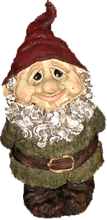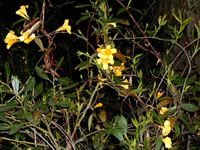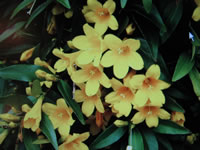How to Grow and care for Carolina Jasmine Vines
Gelsemium sempervirens
       
Melinda wrote: "Hi - thanks for your service.
I have four Carolina Jessamine plants that have been doing well for over 4 years.
One on the end suddenly started getting sick and died. Now the one next to is is starting the same process.
The leaves start turning a reddish color and the plant gets really thin.
HELP! I really want to save them."
|

|
Carolina Jasmine plants are easily maintained, fast growing, climbing vines that grow to about ten feet. They have glossy green, lance shaped leaves and produce fragrant, 1½ funnel shaped,
sometimes clustering yellow flowers for several months in early spring.
They will usually bloom again in the fall.
Growing Requirements for Carolina Jasmine Plants
Unfortunately, Carolina Jasmine is only hardy in USDA zones 8-11.
Carolina Jessamine grows best when its roots are shaded and cool,
but the vine itself tolerates either full sun or partial shade.
They should be planted in rich, somewhat acidic, well-drained soil
that has a lot of organic matter worked into it.
|
Keep the soil moist and feed monthly with a balanced 10-10-10 liquid fertilizer while your Jasmine is actively growing.
Although evenly moist soil is ideal, Carolina Jasmine vines are able to withstand short periods of drought.
|
Pests rarely attack Carolina Jasmine.
Jasmine plants growing in a particular habitat generally do not transplant well since they will need all of their soil, water and light conditions replicated in order to grow.
Having said all of that, I have done nothing to solve your problem.
There has to be a clue in the fact that it is apparently spreading up the line, rather than all the plants ailing at once.
My first instinct was root knot nematode, but most sources say that Gelsemium is practically immune to them.
Jasmine has thick rhizomous roots as well as stems which often run underground for a considerable distance....
Has there been any digging or other changes within 20 feet or so?
The only other thing that I could suggest would be to do a complete soil test for PH, iron, etc. |
|
Pruning and Propagating Gelsemium Plants
Prune Carolina Jasmine immediately after flowering, removing dead or broken branches and shaping the plant.
Carolina Jasmine plants can be easily propagated by air layering,
or from stem cuttings taken from established new growth in the spring
Seeds can be sown directly into the garden in the spring.
Toxicity of Carolina Jasmine Plants
Carolina Jessamine is a very poisonous plant!
All parts of the plant can contain toxic alkaloids.
Eating just one flower has reportedly been lethal to children.
Apparently children think the flowers are honeysuckle, and suck on the blossoms.
The plant can also cause skin allergies in some people and it is possible that the plant toxin
s can be absorbed through the skin, especially if there are cuts.
Carolina Jasmine
Gelsemium sempervirens

 |
|
|
|
Search The Garden Helper:


